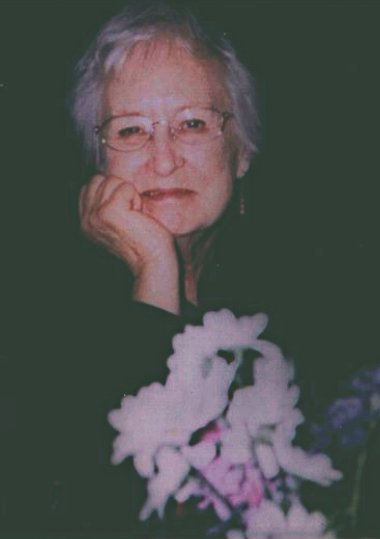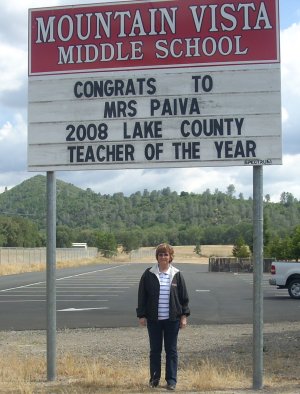
Friends and family members of Pastor Ruth Canady said she's left a legacy of love and service to her community. Courtesy photo.
CLEARLAKE OAKS – Lives well lived often have certain things in common – a sense of sacrifice, vision and great love. {sidebar id=93}
All of those traits were abundant in the life of Associate Pastor Ruth Canady.
Canady, 77, died Aug. 14 at Santa Rosa Memorial Hospital after a brief and sudden illness.
She and her husband, the late Rev. Bill Thorton, became pastors of the Clearlake Oaks Community United Methodist Church in 1998, said her daughter, Charlene Stearns. The couple lived on Cobb, where they ran a retreat, before they were asked to take over the church.
The Rev. Dr. Rick Schlosser, senior pastor of the church today, said when Canady and Thornton took the reins of the church 10 years ago, the congregation was down to 17 people and ready to close.
The renewal that the Thornton-Canady duo began at the church is continuing today. Schlosser, who commutes from Sacramento to lead the congregation, said it has grown to 75 people and has impacted the community around it.
Canady and Thornton nurtured the congregation to take on a vision of making the community a better place as a primary goal, he said.
Always learning
Canady was born June 15, 1931, in Warren, Ark. Her father was an Assemblies of God minister who started a church in Harris, Ark., Stearns said.
Canady's young life changed dramatically during a family vacation to California. The family, while driving west, was involved in a car crash that killed her father and hospitalized her mother with serious injuries.
Following the crash, the 12-year-old girl and her family moved to California, where her mother's family lived.
She didn't graduate from high school as a young woman, but instead went on to marry and raise a family, attending the United Church of Christ and United Methodist Church, as well as the Assembly of God.
Stearns said her mother continued to study throughout her life. When she was in her 40s, she returned to school to get her GED, then went on to junior college before transferring to California State University, Hayward, where she received a bachelor's degree in psychology.
Her psychology degree would lead to work as a hypnotherapist and a practicing ministerial counselor, said Stearns.
Canady and Thornton met at an Assemblies of God church where he was minister, said Stearns. Thornton went on to establish The Renewal Center, an interdenominational church where Canady also came to work.
The two became friends and, in the mid-1980s, married, said Stearns.
They were a devoted team, doing everything together, said Stearns. "They really were soul mates. They really balanced each other in a beautiful way."
In 1989 they bought they Cobb property, where they held hypnotherapy trainings before taking over the Clearlake Oaks church.
Rebuilding a community
The work of rebuilding a church is no small task, but Thornton and Canady took on the task with their unique blend of teamwork and outreach.
Those who knew them said they brought with them a vision for the community, wanting it to become a place where everyone was valued.
They brought to the work a broad and deep spirituality that welcomed everybody, said Schlosser.
The example that they set, he said, included understanding that being a person of faith means following Jesus' example of love and compassion. Loving God and one's neighbor are first, and everything else is secondary.
"It was just an amazing thing," said Schlosser, who said since taking over as minister he has seen every day the fruit of their work in the people who got their message.
Stearns and her sisters said Thornton and Canady believed in giving back to their community and caring for others, making sure everyone knew they were a part of their family.
"They believed that everyone was special in the eyes of God," Stearns said.
They were chaplains for Hospice Services of Lake County, and started Lil Acorns Preschool and counseling services at the church. Under their leadership, the church had a new statement of mission and purpose, which set out a list of goals including providing a place of spiritual growth to all community members, no matter their backgrounds; establishing social programs; sponsoring a senior housing project; and providing career counseling.
"They worked tirelessly, way beyond what the family wanted them to do, but the truth is, it's what they loved, and it was their passion," said Stearns.
John Pavoni wandered into the church in 1998, where he met the couple. He had been looking for a church family but had so far encountered places where he didn't feel at home. He credits Thornton and Canady for giving him back a feeling of equality that he had lost.
After that first meeting, he said Thornton gave him his first "god job," asking Pavoni – of Italian ancestry with a talent for cooking – to help cook for an upcoming fundraiser.
Everyone has such jobs, said Pavoni, in the work of building a community. And once you were done with one, you needed to look for another. "You're never done."
Some of their "god jobs" were bigger than others, such as purchasing and tearing down an old drug house next to the church on the Clearlake Oaks Plaza. Several people went out to tear the house down themselves, with Pavoni, 53 at the time, the youngest of the group. Another participant in the teardown was 82.
Today, the site is the location of the church's Lil Acorns Preschool. Pavoni said Canady had a heart for children, emphasizing the community's responsibility to create a future for them.
Pavoni said there were a lot of great people in the community who were not connected by anything until Thornton and Canady brought them together.
Canady mentored Pavoni, helping him with parenting – he's a foster and adoptive parent – and teaching the importance of caring about others and the power of the spirit.
"There's a greater being there for all of us," Pavoni said of her lessons. "We have to allow ourselves to be found by it and go with it."
Margaret Medeiros joined the church about four years ago. She had read an article about the couple and their work at the church by former local reporter Margaret Gan-Garrison.
So one Sunday morning, which also happened to be her birthday, Medeiros decided to visit the church. "I hadn't been to church for 40 years," she said. "I cried during the whole thing."
The couple's charisma, tenderness and nonjudgmental attitude drew Medeiros, who said she felt an immediate kinship with them. Six months later, her husband Phil joined her at church.
Canady, Medeiros said, "was the glue that kept us all together," a wonderful soul who brought out the best in everyone.
Another chapter
In April of 2005, Bill Thornton died suddenly at age 81. Stearns said her mother was heartbroken, but felt a sense of obligation to stay with the church until a new pastor could be found.
Even after Schlosser arrived, Canady stayed on as an associate pastor. He said he tried to convince her to offer sermons, but her compassionate heart kept her in the role of a very personal ministry that included visiting the sick, and offering counseling and mentoring.
Schlosser said people felt an intimate connection with Canady. "When she was talking to you, you were the center of the universe."
She was constantly on the phone checking with people, said Pavoni, speaking to everyone in the congregation at least once a week. He said she never missed a chance to say "I love you" to those around her, or to show them the value of opening their heart to others and appreciating each day.
Patricia An Schmidt met Canady after being referred to her for counseling through Hospice Services of Lake County.
"I was experiencing a 'spiritual and mourning meltdown' a few months after being widowed in 2005," Schmidt said.
Canady quickly became a mentor to Schmidt, using her feminine instincts and spiritual guidance to help the healing process. Schmidt said Canady also challenged her past and led her to use her personal skills for the church, the church family and the community.
All the people she met were important to Canady, said Schmidt. In the midst of all of that caring for others, Canady was still in mourning for Thornton. Yet, as Schmidt observed, Canady kept her focus and poise.
"I appreciate the time and caring she gave me," Schmidt said.
A sudden end
Ruth Canady's remarkable life ended with dramatic swiftness.
Five weeks before she died, she became ill after being in apparent good health, said Stearns.
Medeiros said Canady thought she had the flu at first. She later was treated for pneumonia, but didn't respond to the treatment.
Eventually, doctors would conclude she was suffering from some type of lung disease which Stearns said was not cancer.
During her last week, Canady was hospitalized in Santa Rosa. Daughter Cheryl Carzoli said the first thing she asked for was her church phone book, so she could call and check in on people.
Pavoni spoke with Canady the night before she died, with her son-in-law holding his cell phone to her ear so she and Pavoni, whom she trained as a lay minister, could pray together.
Later that night, Pavoni and nearly 40 church members gathered at the church for a candlelight vigil to pray for her. "She just meant so much to everybody."
Church members weren't prepared for the news of her death, which occurred early on the morning of Aug. 14.
"I think she decided it was her time," said Medeiros.
A heartbroken Pavoni said he doesn't know if he'll ever heal from her loss, but said his broken heart is held together with the love she gave him.
A lasting legacy
Schlosser said Canady's absence is a heavy one for the church. "It's definitely a huge hole, not just in everybody's hearts but in our ministry that we'll have to find a way to fill.”
Canady had mentored many people, like Pavoni and another congregation member, Ken Young, who are now stepping into lay minister positions.
Pavoni, a nurse by profession, said Canady has inspired him to go back to school, where he's planning to study divinity.
Schlosser said the church is preparing to finish the first phase of its Thornton-Canady Community Center. Stearns said seeing the work come to fruition is very gratifying for the family. She said the family also continues to hear stories from people about how Thornton and Canady touched their lives.
Stearns, who is a Buddhist, said she considers her mother a bodhisattva, a person entirely full of compassion. Carzoli called her mother "a wise crone," while sister Diana O'Hara summed her up as a "soft light."
Schlosser said Canady was absolutely convinced that God, the creator power – "whatever word you want to use" – loved everyone unconditionally. "She embodied that more than any person I've ever known."
The community is invited to a memorial service for Ruth Canady that will take place on Oct. 11 at 4 p.m. at the Thornton-Canady Community Center, next door to the Clearlake Oaks Community United Methodist Church on The Plaza.
E-mail Elizabeth Larson at This email address is being protected from spambots. You need JavaScript enabled to view it..
{mos_sb_discuss:2}


















